29 White Fruits with Pictures and Names — Identification Guide
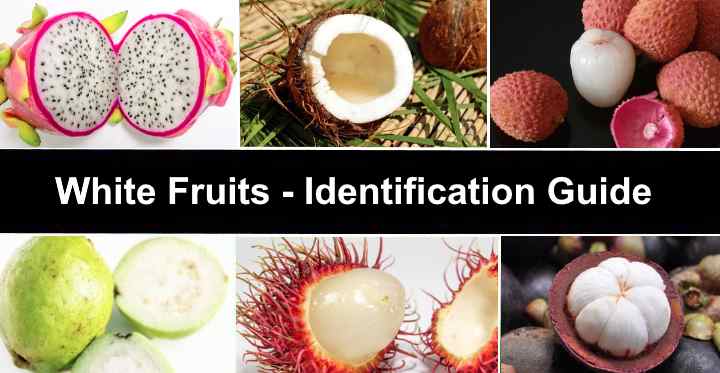
The most common types of white fruits are apples, bananas, pears, and coconuts. These everyday fruits have white flesh and are valued for their delicious and nutritious taste. But did you know that there are many more varieties of white fruits? Some unusual fruits with juicy white flesh include pineberries, dragon fruit, white blackberries, and lychees. Consuming more white berries, pomes, and drupes can diversify your diet and promote good health.
White fruits are delicious and packed with vitamins and minerals we need for a healthy diet. For example, bananas—one of the most common white fruits—are rich in potassium, magnesium, and vitamin B6. Apples contain vitamin C. And if you can eat fruits with their skins, you also get plenty of dietary fiber.
What are the best white fruits to add to your diet? This article has a list of various fruits with white flesh—some common and some not so common.
What Are White Fruits?
White fruits are divided into five main categories. These are pomes, berries, drupes, pepo, and citrus fruits. For example, apples and pears are in the pome category because they have a central seed-containing core. However, berries have a fleshy pulp without a stone. Therefore, bananas and melons can be botanically classified as berries.
Here are quick descriptions of the types of fruits with white flesh:
Pomes: Fruits with a central core containing one or more seeds. Examples are apples and pears.
Drupes: Fruits with a single seed enclosed in a hard, stone-like pit. Therefore, white peaches and nectarines are types of drupes.
Berries: Fruits with pulpy flesh without noticeable stones or pits. However, many berries have pips or tiny seeds. Examples include bananas, white currants, and white watermelons.
Pepo: This type of fruit is called a modified berry. It has a tough outer rind covering juicy flesh. Therefore, melons and cucumbers are pepo fruits.
Citrus fruits: Also called hesperidium, citrus fruits are also modified berries. They have tough, leathery skin and sharp, tangy flesh.
Accessory fruits: These are fruits that develop from several floral organs, not just the ovary. For example, white strawberries and mulberries are classed as accessory fruits, not true berries.
Types of White Fruits
Let’s look in detail at 29 types of white fruits that you can either grow in your garden or find in grocery stores. Some of the more exotic white fruits may be more difficult to find.
Apples (Malus)

Cutting into a red, yellow, or green apple typically reveals white, crispy flesh. The thin peel covers flavorful flesh with a central core containing several seeds. Apples with white flesh offer a balance of sweetness and tartness, making them a popular snack and culinary ingredient.
The apple variety ‘White Transparent’ is a true type of white fruit. This Malus cultivar is ready early in the season. The medium-sized apple variety is characterized by a whitish peel surrounding white flesh. It has a relatively sharp taste and coarse flesh compared to other apples. The peel is pale green but almost translucent, making the apple appear white.
Here is a list of popular apples with white flesh:
Honeycrisp: This apple variety is characterized by its white flesh and mildly sweet taste. It’s an ideal, white-fleshed apple to eat raw or add to salads.
McIntosh: This type of apple has green and red skin surrounding white flesh. The apple has a sharp taste, making it a good all-rounder for eating raw or baking.
Bevan’s Favorite: This early-season apple has firm white flesh and a tart taste, making it an ideal cooking apple.
Golden Delicious: Rich in flavor, this green apple variety is popular for baking or eating raw. It has firm white flesh that stays white when cut longer than other apples.
Pink Lady: Also called Cripps, this sweet apple is easily recognized by its pinkish-red skin and firm white flesh. It’s one of the tastiest apples for eating raw.
Red Delicious: This is one of the world’s most popular apples and is prized for its white, crisp flesh and outstanding taste. It’s a good apple for applesauce, salads, or snacking.
Banana (Musa)

Although bananas are commonly called fruits with yellow peels, they have a creamy white flesh when ripe. Bananas have a sweet, creamy taste with subtle notes of vanilla and caramel. The curled, elongated fruits grow in large clusters called hands. The skin of ripe bananas can be yellow, red, or green.
Described as a “leathery berry,” bananas are ideal for consuming fresh, adding to baked goods, or blending into smoothies. Their sweet, smooth-textured white flesh is rich in potassium, vitamins, and natural sugars. Bananas are one of the most popular and versatile tropical fruits for snacking.
Here are unusual banana varieties with white flesh:
Lady Finger banana: This small, chubby fruit has thin yellow peels and white flesh. The fruit measures around 5” (13 cm) long and has a honey-like flavor.
Barangan banana: This yellow banana has tiny black dots on its peel that surround seedless white flesh. Its sweet, mild flavor makes it a popular dessert banana.
Blue Java banana: Its greenish-blue peel and white flesh make it one of the most unusual bananas you can find. It has a sweet, vanilla taste like ice cream.
Cavendish banana: This is a large type of yellow banana and one of the most popular worldwide. It has soft, sweet flesh, making it an ideal fruit for desserts, smoothies, banana bread, or snacking.
Coconut (Cocos nucifera)

Coconut is the fruit of the coconut palm tree and is known for its pure white flesh, sometimes called “coconut meat.” This tropical drupe has a meaty texture and a mildly sweet and nutty taste. A hard, fibrous exterior surrounds the white flesh. You can grate, shred, or slice the hard flesh.
Coconuts range in size depending on the variety of palm tree. For example, dwarf coconut palms produce small nuts with green, orange, or yellow skins and white flesh. Typical coconut palm trees grow up to 100 ft. (30 m) tall and have an easily recognizable crown of arching pinnate leaves.
Coconuts typically weigh around 3 lbs. (1.4 kg). Young coconuts have soft white flesh with a liquid called coconut water. As the drupe matures, the fleshy white interior hardens.
Chinese White Pear (Pyrus bretschneideri)
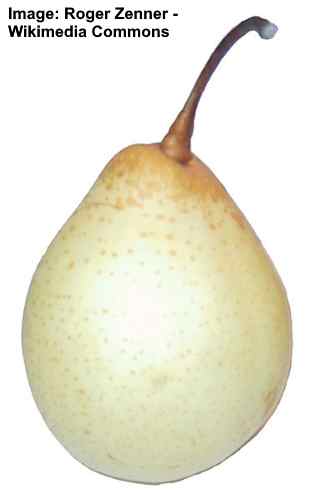
Also called pearple, this white pome has a classic pear shape and white, juicy flesh. Native to China, the medium-sized fruit has a round base that tapers slightly at the top, like European pear varieties. The white flesh is crisp and juicy but not as sweet as other pears, like the Bosc pear.
The Chinese white pear is versatile, making it ideal for snacking or using in cooked foods. Its crisp flesh and pale creamy-yellow skin make it perfect for poaching or baking. However, its sweet and fragrant flesh is a delicious, juicy snack. The white-fleshed pears are usually ready for harvesting in late summer or early fall.
Bosc Pear (Pyrus communis)

The Bosc pear is a white fruit with russet skin and a classic long tapering neck, common to most European pears. The juicy flesh of the Bosc pear is off-white with a dense, crisp, smooth texture. The pear’s brownish skin is covered in small lenticels, giving it a rough, bumpy appearance.
Due to their firm and solid flesh, Bosc pears are versatile white fruits for snacking and cooking. They maintain their shape throughout poaching, making them the go-to choice for creating tasty desserts. It tastes like the Chinese white pear. When fully ripe, the pear is sweet and soft with wrinkly skin.
Other types of pears with white flesh include the following:
Bartlet pear: This popular plump pear has reddish-green skin, a classic “pear” shape, and juicy white flesh. It is typically ready for eating from mid-August. It’s one of the most popular pears in the United States.
D’Anjou pear: This type of white fruit has sweet, juicy flesh and smooth green skin with russet spots. Compared to Bosc pears, the D’Anjou variety hardly tapers near the stem end, giving it a unique appearance.
Nashi pear: This variety is prized for its white inside, round shape, and small core. The white fruit has thin skin in a pale golden-yellow color. The succulent pear’s flesh is fresh, refreshingly crisp, and slightly sweet. Some describe its flavor as a cross between a pear and an apple.
White Currants (Ribes sativum)

White currants are small white fruits with a sweet taste and attractive appearance. The pale-colored currants grow in drooping clusters on small fruit bushes. Ready for picking in the summer, the berry-like fruits are firm and juicy. Compared to red currants, they are smaller and sweeter.
White currants are delicious white fruits that add a tangy yet sweet twist to desserts, jams, and jellies. The small, round, translucent berries also work well in fruit salads, pies, tarts, and savory dishes. In addition to their delightful taste, they are a rich source of vitamin C and other beneficial nutrients.
White Mulberries (Morus alba)
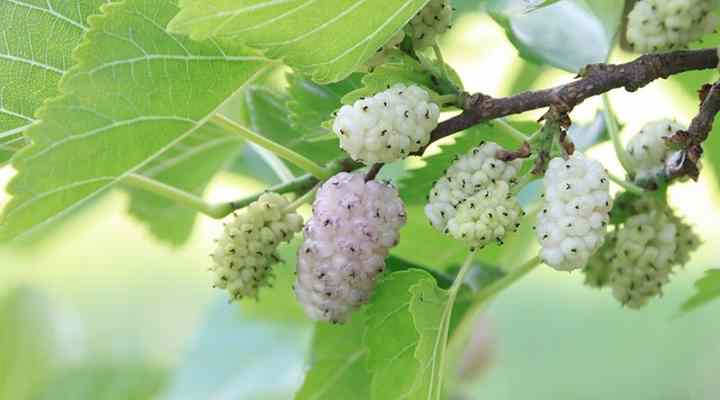
White mulberries are a type of white accessory fruit that looks like white blackberries. The white berry-like fruit is about 1” (25 mm) long. It has a deliciously sweet, mild flavor with a slight tartness. The white flesh is extremely soft when ripe, and therefore, they don’t store well.
When ripe, white mulberries turn from green to creamy yellow or ivory colors. In their native China, the white fruits were used to feed silkworms. In other countries, the sweet and juicy berries are used for making jams, jellies, and preserves. Their exquisite sweetness makes them perfect for incorporating in pies, tarts, and cakes.
White Strawberries (Pineberry) (Fragaria chiloensis x virginiana)

Also called pineberries, white strawberries are an unusual white fruit with a distinctive pineapple flavor. The berry-like fruits are white to ivory in color with bright red speckles. They also have a classic strawberry shape—broad at the top and tapering to a point. The white flesh is soft and aromatic with a tropical taste.
White strawberries may look like unripe red berries. However, they are perfectly ripe when white or white with pink blush. They stay white because the accessory fruits lack the protein Fragaria allergen 1—the compound responsible for the vibrant red color of traditional strawberries.
Here are some varieties of white strawberries you may find in specialist fruit stores or grow at home:
Pineberry ‘Snow White’ (Fragaria x ananassa): The small white fruit has vibrant red seeds that stand out against the ivory, slightly pinkish flesh. You can grow them in the ground, in containers, or in hanging baskets.
Alpine strawberries (Fragaria vesca): This small, wild strawberry variety has a unique flavor like pineapple or honey. They are smaller than other white varieties, with each fruit typically measuring between 0.19” to 0.39” (5 – 10 mm).
South American strawberries (Fragaria chiloensis): This large white strawberry variety has white flesh with pinkish shades and bright red seeds. The white fruits can measure up to 1.57” (40 mm). When ripe, the white strawberries are extremely sweet and fragrant.
White Honeydew Melon (Cucumis melo)
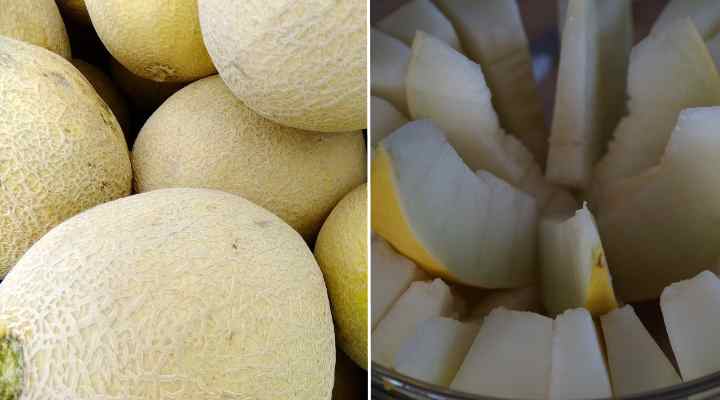
White honeydew melon has a pale greenish-yellow to white rind and whitish-green flesh. The succulent honeydew melon has dense, thick flesh with a sweet, floral, and slightly fruity flavor. The seed cavity of the white melon has tan seeds and white, stringy fibers. Honeydew melons have an overall round shape.
The sweet, refreshing taste of white honeydew melons makes them perfect for consuming fresh. Their floral, sweet flavor enhances the taste of fruit salads, smoothies, and savory salsas. You can also wrap them with prosciutto or other cured meats for a sweet and savory dish.
Canary Melon (Cucumis melo)
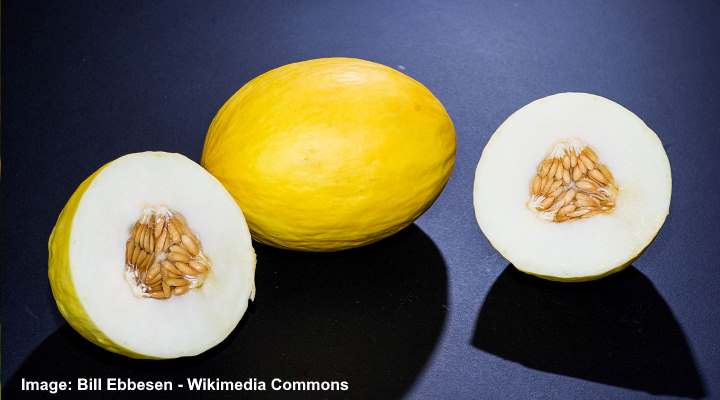
The Canary melon is a bright yellow fruit with juicy, sweet, white, ivory, or pale green flesh under its thick rind. This melon variety has a sweet but tangier flavor than honeydew melons. Its name comes from the vibrant yellow skin reminiscent of canary birds. When ripe, the white-fleshed pepo fruit has a waxy, bumpy feel.
Like the white honeydew melon, the canary melon is a type of muskmelon in the family Cucurbitaceae. It ripens in late summer and fall, and its thick rind gives it a long shelf life. Therefore, it’s also called a winter melon.
White Nectarines (Prunus persica var. nucipersica)

White nectarines are a type of drupe with smooth, creamy-white flesh. Similar in size to an apple, white-fleshed nectarines have reddish skin with patches of yellow and green. Its white flesh is succulent and juicy and should be slightly firm when ready to eat. Its taste is described as sweet with honey, vanilla, and warm spice overtones.
White nectarine is a stone fruit closely related to peaches. Its taste is more subtle than typical yellow peaches or nectarines. The fruits are typically in season during summer, making for a delicious snack. Alternatively, you can incorporate them into a variety of recipes. They can be sliced and added to salads, used as a topping for desserts, or even grilled for a unique twist.
Like other types of Prunus fruits, white nectarines are a good source of vitamins, minerals, and dietary fiber.
Ripe white nectarines should be firm yet slightly yielding to gentle pressure. It’s best to avoid any that are overly soft or have bruises or blemishes. To ripen them further, leave them at room temperature for a few days until they reach your desired level of ripeness. Once ripe, you can store them in the refrigerator for a few days to extend their shelf life.
White Peaches (Prunus persica)
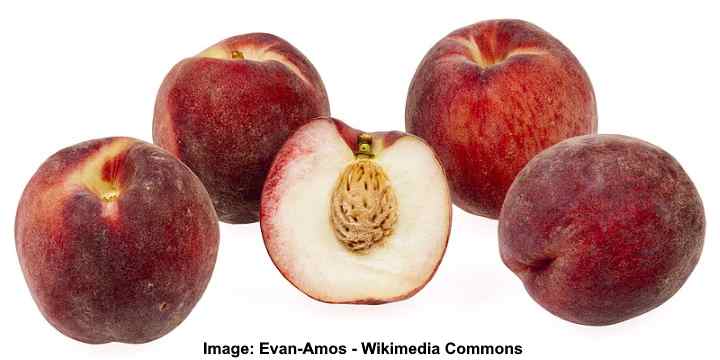
White peaches are small to medium-sized drupes with a round or oval shape and pale, creamy white flesh. These delicious stone fruits are known for their sweet, juicy flavor and hint of tartness. Hints of dark red are sometimes visible on the white flesh around the stone.
White peaches have a softer texture compared to yellow peaches. The pinkish-red thin skin has a slightly fuzzy feel and a fragrant aroma. Ripe white peaches should have a floral scent and give slightly when gently squeezing them. White peaches are typically available in summer.
It’s best to avoid peaches that are overly soft, bruised, or have moldy spots. To ripen firm peaches, leave them at room temperature for a few days until they yield to gentle pressure.
White Blackberry (Rubus fruticosus ‘Snowbank’)

White blackberries are an unusual type of white accessory fruit hybrid. The tasty white fruits taste similar to traditional blackberries but are slightly sweeter and tarter. However, their fascinating white color sets them apart from their black counterparts.
White blackberries are an uncommon white fruit and are considered a delicacy. Their pale, almost translucent appearance makes them visually striking, especially when contrasted with the dark green leaves of the blackberry plant. However, they are easy to grow in containers or a fruit garden if you want to enjoy the white fruits.
White blackberries ripen in the summer. They are more delicate than typical blackberries; therefore, handling them gently when picking is essential.
White Raspberry (Rubus idaeus)
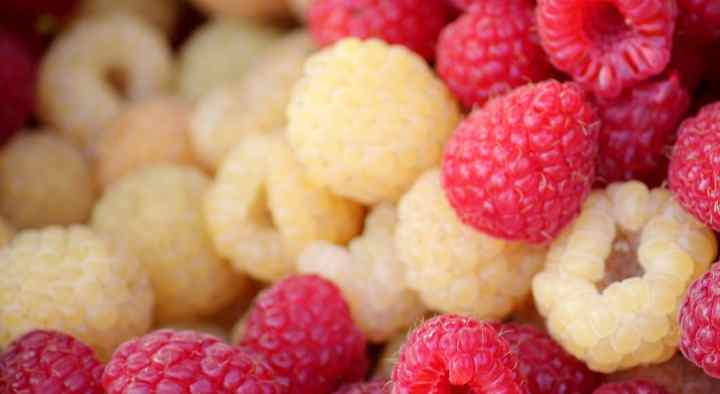
Some varieties of yellow raspberries are light, pale shades, making them appear almost white. The pale yellow, almost white fruits have soft, tender flesh that is remarkably juicy. They also have a slight crunch because the warm, cream-colored, berry-like fruits contain up to 200 seeds.
White raspberries are aggregate fruits developed from fused droplets. The lack of traditional raspberry red is due to a gene that inhibits anthocyanin production—the compound that gives fruits a red color.
White raspberries are difficult to find. However, you can buy varieties of the fruiting plants to grow the canes at home in sunny gardens.
Dragon Fruit (Pitaya)

Dragon fruit is a vibrant, exotic tropical fruit with grayish-white flesh dotted with tiny black seeds. Native to South America, this unique cactus fruit is easy to identify due to its bright pink skin and green scaly spikes. Dragon fruit has a mildly sweet and refreshing flavor with a texture and taste like kiwi or melon.
You can eat dragon fruit raw. Simply cut it in half and scoop out the flesh with a spoon. You can eat it as it is or add the juicy flesh to smoothies or fruit salads. Additionally, its eye-catching appearance makes dragon fruit ideal for garnishing desserts. Like most tropical fruits, the pink-skinned fruit is packed with vitamin C and dietary fiber.
Also, dragon fruit skin or peel is edible. You can eat the skin of dragon fruit if you wash it thoroughly first. Then, you can cut the fruit into chunks, leaving the vibrant pink skin on. The contrast of hot pink shades and black-speckled white flesh will be a talking point at a dinner table, picnic, or barbecue.
Lychee (Litchi chinensis)
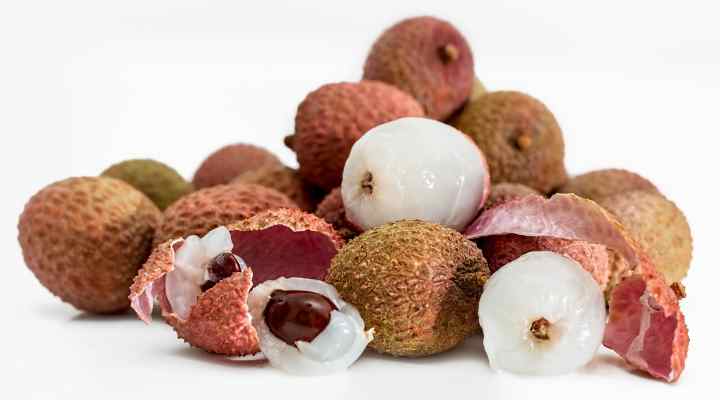
Lychee is a small, rounded, white tropical fruit covered in a rough, reddish-brown outer skin. The fascinating white flesh is almost translucent and has a juicy texture. The succulent white flesh has a sweet, fragrant taste. The round white fruit contains a large chestnut-brown seed.
Lychee white fruits measure 2” (50 mm) long and 1.6” (40 mm) wide. The fruit is a type of aril—a fleshy pulp surrounding a single seed. Due to their round, translucent, white-eye-like appearance, lychees are often called “dragon eyes.” They are typically consumed fresh, straight from the tree
You cannot eat lychee skin. However, peeling off the skin is straightforward to reveal the white, fleshy, edible portion. Lychees are popular desserts, fruit salads, smoothies, cocktails, and ice creams.
Soursop (Annona muricata)
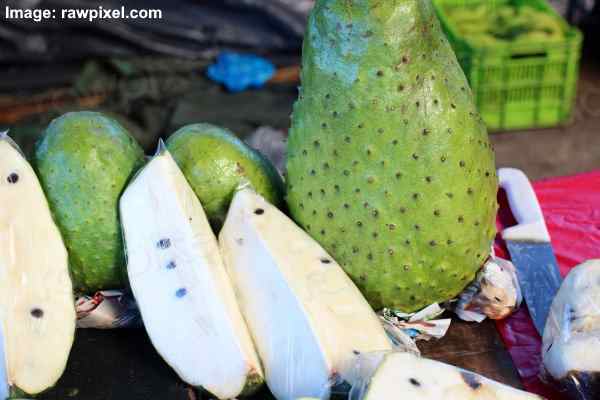
Soursop is a large, spiky green fruit with white, creamy flesh and small black seeds scattered throughout. The ovoid fruits grow up to 12” (30 cm) long and have a prickly exterior. The edible white pulp has a unique flavor, described as a combination of pineapple and strawberry, with a hint of citrus.
Soursop is a delicious and nutritious fruit with a slightly acidic taste you can enjoy in several ways. It’s a popular white fruit to use for making sweet drinks, smoothies, or fruit nectar. It’s also an ingredient in some ice creams, sorbets, and desserts. It’s delicious and rich in vitamins and minerals, including vitamin C, potassium, and dietary fiber.
Cherimoya (Annona cherimola)
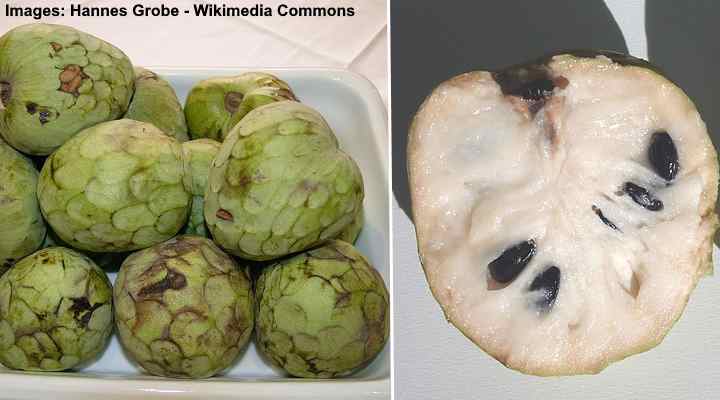
Also called the custard apple, cherimoya is a delicious fruit with a creamy white pulp native to South America. The exotic fruit has a green, rough exterior with a scaly texture. The smooth, custard-like texture of the white flesh contains several large, inedible seeds. The heart-shaped or oval fruit weighs 1 lb. (0.5 kg) on average.
Custard apples are ready for harvesting when their green, knobby skin is firm but yields to gentle pressure. To enjoy the delicious fruit, chill it, cut it in half, and scoop out the creamy white flesh with a spoon. The texture and taste are a combination of banana, pineapple, and coconut flavors.
If you remove the seeds, you can add the creamy white pulp to desserts, ice cream, and smoothies. Cherimoya is a unique and delightful, white-fleshed fruit if you want to enjoy a sweet tropical fruit with a creamy texture.
White Sapote (Casimiroa edulis)
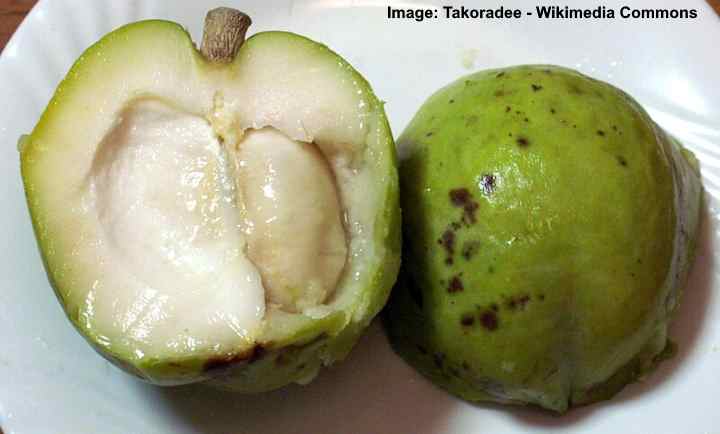
White sapote is a type of drupe with creamy-white edible pulp and can taste like banana, pear, vanilla, or peach. The tropical fruit measures 2” to 4” (50 – 100 mm) in diameter—the size of a medium apple—and has an ovoid shape. Its fleshy pulp has a creamy custard texture and up to five seeds.
White sapote fruit is mature when soft to the touch and is yellowish or green. You can also eat the thin skin. The fruits are difficult to find in stores, and you can sometimes buy them in farmers’ markets or specialist grocery stores. However, the small to medium-sized tree is easy to grow in USDA hardiness zones 10 and 11.
Rambutan (Nephelium lappaceum)
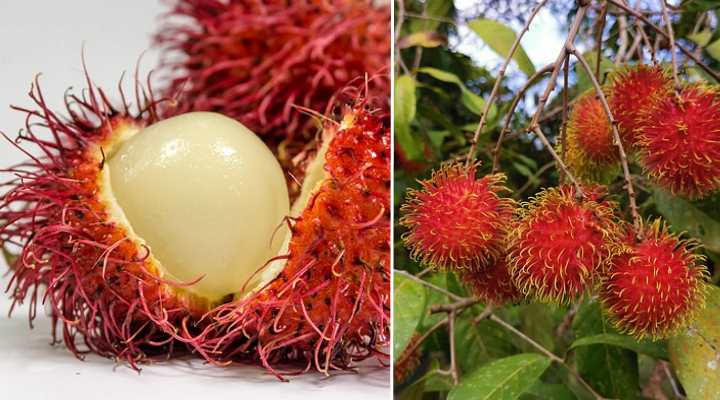
Rambutan is a spiky fruit with white flesh inside. The tropical drupe has a round, hairy exterior covering whitish, translucent flesh and a single glossy brown seed. The white flesh tastes like grapes with a slightly acidic taste. The red, spiky fruits measure up to 2.3” (60 mm) long and 1.6” (40 mm) wide.
Rambutan is a tropical white fruit native to Southeast Asia. Its name comes from the Malay word “hairy” because of the fruit’s fleshy spines covering its exterior.
Rambutan fruit tastes like lychee fruits. They have a sweet, fruity flavor with a slightly acidic taste, like grapes or strawberries. The skin and seed are not edible. You can eat the tropical fruits raw after removing the seeds. Or you can include rambutans in deserts, puddings, and sorbets.
Rambutan fruit is good for its nutritional benefits. It contains nutrients, including vitamin C, fiber, and antioxidants. Also, they are a good source of potassium, vitamin B5, and folate.
Longan (Dimocarpus longan)

Longan is a tropical white fruit that hangs in drooping clusters. The drupes are also called “dragon eyes” because they have translucent, juicy white flesh surrounding a large black seed—like a large eyeball when the skin is removed. The flesh is sweet and aromatic, with flavors of honey and floral notes.
Longan fruits are related to rambutans and lychees. The round fruits measure 1” (25 mm) across and have leathery skin covered in tiny hairs.
To enjoy the sweet, white flesh, simply peel off the skin to reveal the strange fruit that looks like an eyeball. After discarding the seed and skin, you can eat the white fruit raw as a snack. It also is a useful ingredient in desserts, Asian soups, and sweet-and-sour dishes. Compared to lychees, longan fruit has a tarter flavor.
Mangosteen (Garcinia mangostana)
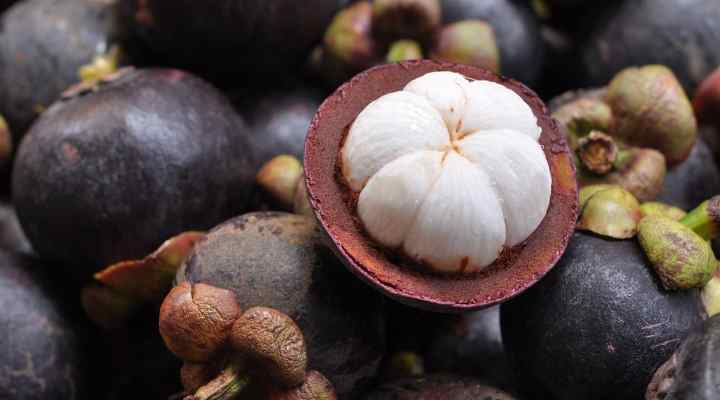
Mangosteen is a weird tropical fruit with juicy, tangy white segments like citrus fruits. A thick, inedible, deep reddish-purple rind covers the white fleshy parts. The shape and size of white mangosteen fruits is the same as a tangerine—1.5” to 2.5” (40 – 60 mm) across.
Peeling away the purplish rind reveals white, fruity, wedge-like segments arranged like an orange. The flavor of the fruit is sweet and tangy, with a hint of citrus, giving it a distinctive sweet and sour taste.
You can enjoy mangosteen fruit on its own as a refreshing snack. When using it in culinary preparations, it is best to use the fruits soon after picking or canned as they don’t store well. The tasty white segments add a burst of flavor to curries, salads, or desserts.
Noni Fruit (Morinda citrifolia)

Noni fruit is a unique fruit with white flesh and large pips. Native to Southeast Asia, the oval-shaped fruit ranges in size from a small potato to a large egg. The young fruit has green skin with a bumpy texture that turns from green to yellow or white when ripe. The fruit has a strong, pungent smell and bitter taste.
Noni fruit is an acquired taste due to its strong cheese-like odor. It also goes by the names cheese fruit and vomit fruit. Therefore, it’s called a famine food or starvation fruit because of the unpleasant taste. However, other parts of the tree are used in Asian cuisine. The edible seeds can be roasted, and the leaves can be cooked with coconut milk.
Langsat (Lansium parasiticum)

Langsat is a tropical white fruit about the size of small potatoes growing in clusters. The fruit has a thin, leathery, pale yellow skin. Peeling the skin reveals a cluster of translucent lobes resembling peeled garlic. The fleshy pulp tastes like a combination of grapefruit and grapes.
The juicy flesh, with its balance of sweetness and a hint of sourness, makes for a delicious snack when eaten fresh. It’s also popular for fruit salads, desserts, jams, and candies.
White Guava (Psidium guajava)

White guava is a tropical fruit with white, firm flesh and a sweet, tart, tangy flavor. The green-skinned fruit is round or pear-shaped and is yellowish-green when ripe. The white flesh has a firm consistency that is still soft and tender with a slightly grainy texture. Its juicy pulp also contains vital nutrients like vitamins and minerals.
White guava differs in size and appearance from traditional guava fruits with red flesh and a pear shape. Tropical white guava flesh has a higher sugar content than the red variety. However, it has more acidity, giving it a sweet and sour taste with overtones of musky melons.
The tasty flesh of white guava has many practical uses in culinary practices. The white flesh and edible seeds are tasty raw. Or you can add chopped white guava to salads, smoothies, and mixed fruit bowls. You can also use them in savory dishes to add natural sourness and sweetness to Asian dishes. Or you can use them to make juices, jams, and desserts.
White Aspen (Acronychia oblongifolia)

White aspen produces small, round white fruits that have strong citrus flavors with hints of honey. The glossy white fruits have a crisp texture, fresh aroma, and tasty flesh. The berries emerge green in late fall and gradually turn white as they mature. This subtropical white-fruiting tree is native to Australia.
The fleshy, edible white fruits are delicious on their own. Fresh, white aspen fruits also accompany side dishes and salads. Their citrusy taste and sweet aroma mean they go well with poultry or seafood. It’s also possible to make juices, jams, and syrups from cooking the white fruits.
Breadfruit (Artocarpus altilis)

Breadfruit is a large, grapefruit-sized tropical fruit containing white flesh with a starchy, bread-like texture. The large fruits have a green peel with a rough surface covering a dense inner flesh. Each breadfruit tree produces up to 200 fruits per season, making it an exceedingly high-yielding food plant.
The large and round breadfruits can weigh 0.55 to 13 lbs. (0.25 – 6 kg). The fruit’s inner flesh has a starchy taste reminiscent of yams or potatoes with slightly nutty overtones. Cooked breadfruit can taste like freshly baked bread.
The fruits of the breadfruit tree have several uses as food—both raw and cooked. For example, raw breadfruit can be ground into flour. Also, the ripe and unripe flesh can be fried, baked, boiled, or roasted. Additionally, the flesh can be chopped and used as an ingredient in curries, stews, and saucy meat dishes.
Baobab Fruit (Adansonia)

Baobab fruit is an unusual fruit with a creamy-white to light beige pulp that hardens into a crumbly powder. The fruits are typically large and have an oval or egg shape. Opening the ripe fruits reveals chunks of dry pieces with a chewy texture. Eating the fruit leaves a floury taste in the mouth. The fruit also has edible brown seed kernels.
Native to Africa, baobab fruit has a sweet, tangy flavor with hints of lemons, pears, yogurt, and vanilla. The brown seeds taste like Brazil nuts. However, consuming the nuts and chalky flesh together is not recommended as they create an unpleasant taste.
You can eat the raw white, powdery flesh inside the fruit or use it as a natural sweetener in various dishes. Typically, people grind the dry, chalky pieces into a fine powder to use in stews, soups, or baked products. It can be added to smoothies, juices, and desserts.
Jujube Fruit (Ziziphus jujuba)

Jujube fruit is an edible oval drupe resembling a reddish-brown date. Its flesh is greenish-white and has the taste and consistency of an apple. The small fruit has two pointed seeds like olive pits. The date-like fruits measure 0.6” to 1.1” (15 – 30 mm) long.
Also called the Chinese date or red date, jujube fruit is usually consumed as a snack after drying the fruits that look like wrinkled dates. Its taste is described as sweet with a slightly tart flavor. In some countries, it’s popular to crush the greenish-white pulp to create a refreshing drink.
Jujube fruit is native to Southeast Asia and is a popular fruit-producing shrub or small tree. The red date-like fruits are ready for eating in the fall.
Related articles:
